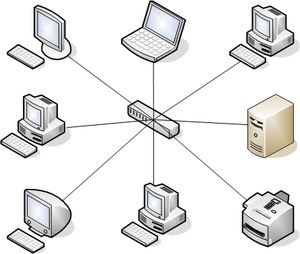Star network facts for kids
Star networks are a very common way to connect computers and devices. Imagine a star shape: all the points connect to the center. In a star network, every computer or device connects to one central point. This central point is often a special device called a switch or a hub. It helps send messages between all the connected devices.
Contents
What is a Star Network?
A star network is a type of computer network layout. It gets its name because it looks like a star. All the devices, like computers or printers, connect directly to a central device. This central device acts like a traffic controller. It makes sure messages go to the right place.
How Does a Star Network Work?
When one computer in a star network wants to send information to another, it sends the message to the central device first. The central device then forwards the message to the correct computer. It doesn't send the message to everyone. This makes the network more organized.
The Central Hub or Switch
The central device is very important. It can be a hub or a switch.
- A hub is simpler. It takes a message from one device and sends it to all other devices connected to it. This can sometimes make the network slower.
- A switch is smarter. It knows exactly which device needs the message. So, it sends the message only to that specific device. This makes the network faster and more efficient. Most modern star networks use switches.
Why Use a Star Network?
Star networks are popular for many good reasons. They are often used in homes, schools, and offices.
Easy to Set Up and Manage
Setting up a star network is usually simple. You just connect each device to the central hub or switch. Adding new devices is also easy. You just plug them into an open port on the central device.
Good for Troubleshooting Problems
If one computer or cable has a problem, it usually only affects that one device. The rest of the network keeps working. This makes it much easier to find and fix problems. You don't have to shut down the whole network to fix one part.
Reliable Network Connection
Because each device has its own cable to the central point, there are fewer chances for messages to get mixed up. This makes the network more reliable. If the central device works well, the whole network works well.
Disadvantages of Star Networks
Even though star networks are great, they do have some downsides.
Single Point of Failure
The biggest problem is the central device. If the hub or switch breaks down, the entire network stops working. No device can send or receive messages. This is called a "single point of failure."
More Cabling Needed
Each device needs its own cable running to the central point. This means you might need more cables compared to some other network types. For very large networks, this can become expensive and messy.
Cost of the Central Device
The central hub or switch can be an extra cost. A good quality switch, especially for a large network, can be expensive.
Where Are Star Networks Used?
Star networks are very common in many places.
Home Networks
Many homes use a star network setup. Your Wi-Fi router often acts as the central hub or switch. All your devices like computers, phones, and smart TVs connect to it.
School and Office Networks
Schools and offices often use star networks. Each classroom or office might have its own switch. All the computers in that room connect to it. This helps keep the network organized and easy to manage.
Small Businesses
Small businesses also find star networks useful. They are simple to set up and maintain, which is good for businesses without a dedicated IT team.
See also
 In Spanish: Red en estrella para niños
In Spanish: Red en estrella para niños


